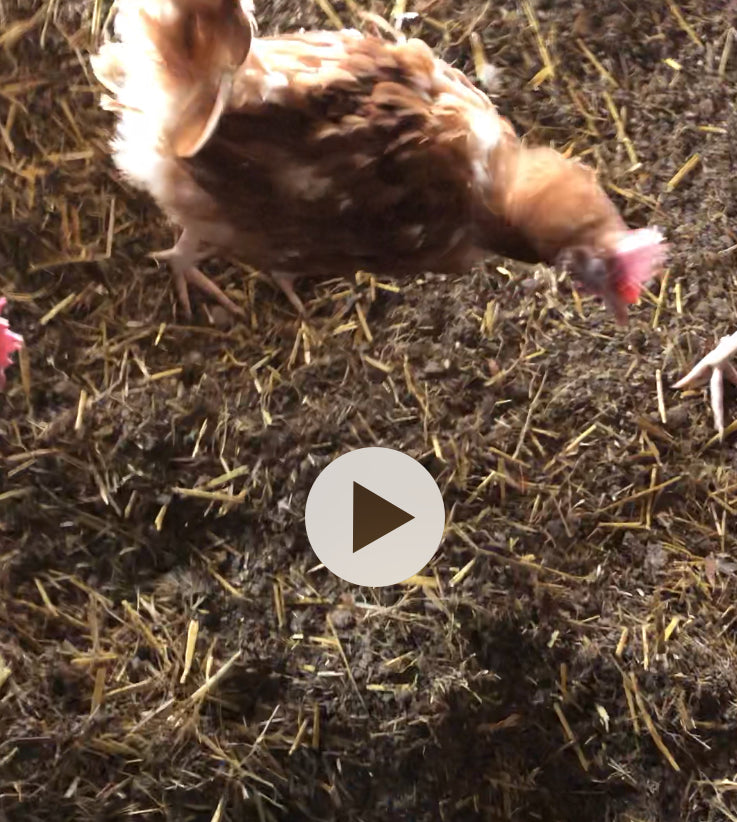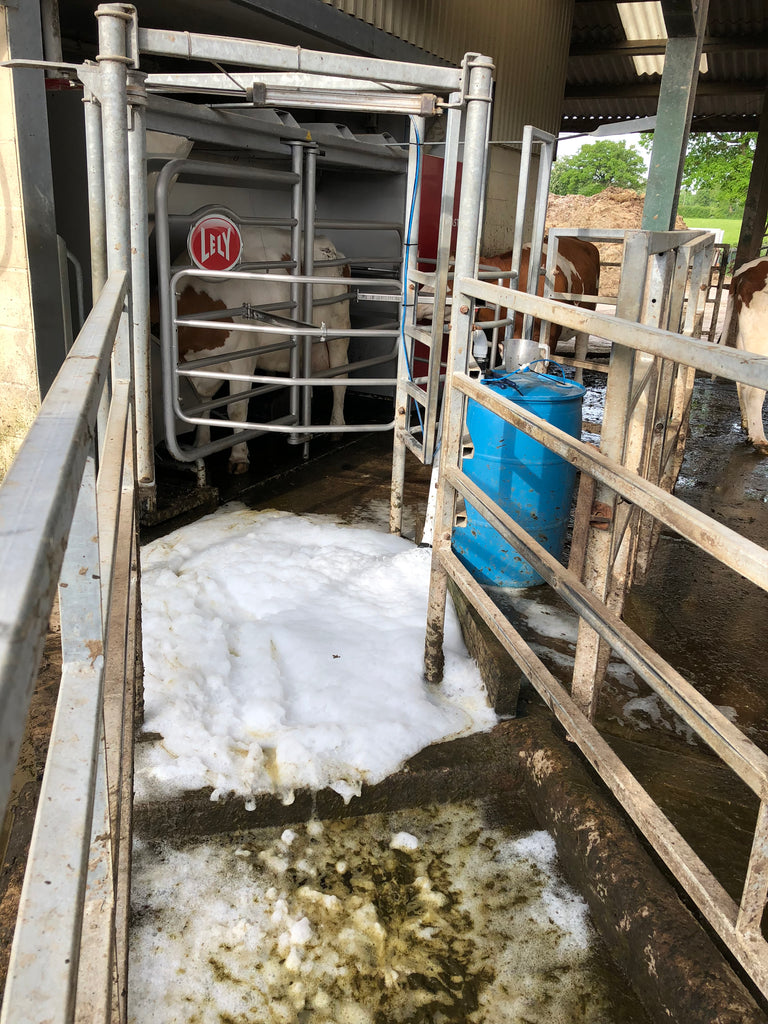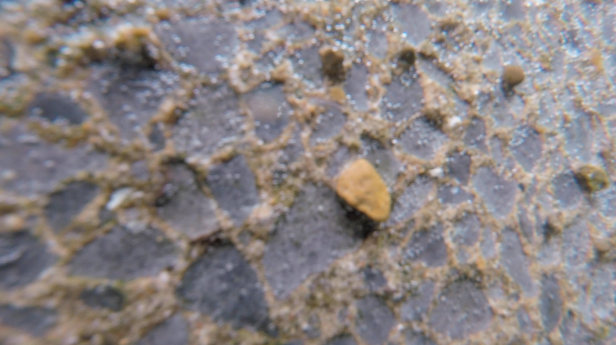News
Strep Uberis sub clinical and bactoscan rising
Spring calving cows just can't be lame
Grazing animals, walking long distances simply can not be lame. Bacterial infections of their feet increase stress and pressurise their immune systems. Pruex has developed a new strategy to help limit such stress by applying AHC bacteria via a foam to the cows feet post milking. The aim of this strategy is to limit the need for antibiotic treatment of lame cows.
Dry litter reducing infective bacterial pressure
The litter in this flat deck free range laying bird unit is drying up nicely. Having audited the extent of the issue and recommended a protocol for Pruex products, the visual affects are tangible. Mortality rates are low and production has reverted to what one would hope to be getting at fifty weeks. There is no putrid ammonia type smell within the building.
Dry, clean bedding for healthy environments
A daily misting of AHS has developed a dry, clean, non infective bedding in this calf shed. Even though there was an extended wet winter this year, forty calves per pen probably managed to develop a strong immune defence system here. This was measured by a lack of scour or respiratory sickness which tupically hit calves in these buildings in other years.
Surround housed young animals in non infective environments for health.
The video below shows examples of Pruex AHS Mist being applied.
Why do our grazing animals get sick?
When calves are born outside at pasture, the first thing they come in contact with is typically soil, or dirt. The cows’ udders are typically dirty, ‘contaminated’ with soil, yet the calves are typically healthy, cow recovery rate good, and farmer focus is typically on the weather with a view to securing harvest.
When calves are born inside, the envir- onment can be less harsh, dry, sheltered and to the human eye, comfortable to the cow and calf. Yet, typically, calves get sick. If not scouring almost straight, then within days, ahead of damaging infections.
The founder of Pruex.co.uk, Aled Rhys Davies’ mother tongue is Welsh, but that’s not the reason he struggles with the notion of soil contamination. His Nuffield Farming Scholarship looking at ‘Alternatives to Antibiotics in Agriculture’ taught him that animals don’t live in sterile conditions, and like us humans, are surrounded by bacteria and other micro flora. This is far from a static scenario, as all of the different types of bacteria, algae, yeasts, protozoa and others compete for dominance in terms of population density against each other with- in the same space as us and other animals. In Nature, there are more non-infective bacteria than infective ones. Typically, soil is dominated by ‘good bacteria’ that rather than contaminating us and our animals, protect us by preventing ‘bad bacteria’ from becoming dominant in our environments and making us sick.
When housed, the ratio of good bacteria to bad bacteria is typically reversed. There is no soil, but there is a great amount of faecal contamination. Moisture and nutrients from urine and even condensation compound the spread and dominance of infective bacteria in the animals’ direct environment.
When animals are housed and ‘bad bact- eria’ are allowed to dominate the environment, young and vulnerable animals are at a real risk of contracting disease. The air they breathe can become full of toxic bacteria that can cause disease such as pneumonia. The water they are given to drink can be full of toxic bacteria despite chlorination. If they develop any cuts or abrasions, then access to the bloodstream for infective bacteria is helped. Keeping housed animals in this type of environment increases the stress on the animal. Equally, giving grazing animals putrid water increases the risk of infection.
Rather than attempting to kill all bacteria constantly with disinfectant, Aled found a new technology used in hospitals in Euro- pean, Northern American and Australian hospitals to lower the risk of infections. There, they clean the wards that have anti microbial resistant bacteria by applying non- infective bacteria to surfaces. A light bulb moment for Aled, he realized that what they were actually doing in those hospital wards was adding soil to the surfaces without adding dirt. In other words,
they were adding ‘good bacteria’ so that the ‘bad bacteria’ didn’t become dominant. He realized that this strategy is the same as what happens in nature within soil. Having realized this, Aled founded Pruex Ltd to take a lead in the fight against anti microbial resistance. He works with farmers to find out if their buildings and water sources are dominated by infective bacteria or are healthy. He supplies non-infective bacteria, which farmers apply to surfaces in the animals’ environments, and to water sources, similar to how the technology is used in hospitals. This results in similar or better bacterial balance to what is found outside at pasture.

Trough with thick contaminating biofilm layer

Trough with algae contamination

Water trough bath with contaminating biofilm layer
Iron based biofilm in pipe
Manganese based biofilm in pipe
Manganese biofilm
Pipe treated, showing clean. Previously it had a Manganese Biofilm
The response witnessed from applying non-infective bacteria to the animals’ environments has surprised Aled. “I started Pruex with the aim of helping farmers limit the need for antibiotics by reducing stress on their animals. What I’m finding is that by doing so, the animals respond with production increases. I certainly didn’t expect to see their bedding drying up as a result of applying non-infective bacteria to it, but that is a consistent finding, and with straw being so expensive this year, having to use less as a result is fantastic news”

Clean water in trough post Pruex treatment to continue to remove biofilm

Stephen Barbour applying Animal House Stabiliser to cattle bedding.
Pruex Ltd work with many species of animals, including beef. Whilst cattle are housed at Winterwell beef unit, Somerset, part of the Straight Line Beef company, Pruex supply a non infective bacterial product which is added to their bedding to help limit the risk of infection from toxic bacterial colonies. The objective being to provide as healthy an environment as possible for the housed cattle. Their water is also supplemented with Pruex non infective bacteria to limit biofilm within water pipes. Rob Drysdale, beef producer and integrator, consultant farm vet, and Nuffield scholar, who developed Straight Line Beef states that “Clean water drives dry matter intakes, which improves daily live weight gains”. He has a point. Aled Davies of Pruex knows all too well how biofilm can limit animal production. “We see all sorts of infective colonies of bacteria dominating the surfaces of water troughs and causing all sorts of water pressure issues by almost clogging up water pipes. The animals that have this water to drink respond favourably in terms of production once we get their water sources clean”, says Aled.
You might not have heard of biofilm, but have lived with it daily all your life. Plaque on your teeth is a form of biofilm. A morning brushing of teeth results in the need to repeat the process by the evening. A bacterial slime, biofilm, re grows on your teeth. It’s built by bacteria using minerals and a source of carbohydrate, (sugar). Mouth wash doesn’t penetrate the biofilm effectively, so the mechanical process of brushing is the most effective means of reducing this biofilm. Biofilm on our teeth is white due to the mineral being calcium, from our teeth. The biofilm in water troughs tends to be a black slime if the mineral is manganese, or red if the mineral used by the bacteria is iron. This biofilm slime protects toxic colonies of bacteria which secrete their poisons into the surrounding water, which supplies a constant challenge to your animals’ immunity, every time they drink. Biofilms persist in our water systems despite chlorination, so, are problematic to stockmen all over the country.
“Pruex supply a solution in the form of non infective bacteria” explains Aled Davies. “Our product ‘Water Plus’ is applied by pump at source to the water. This has the effect of weakening biofilm, which is then removed by the flow of water through the water pipes. The water pipes become clean of biofilm, the troughs quickly begin to look brand new again, and water intakes increase as the toxins are reduced”.
Stockmen all across the country will recognize biofilm within water troughs. They will also know how health issues can reduce returns to their businesses. Finding new and innovative ways of limiting risk of infection as identified by Pruex, as opposed to using antibiotics to treat bacterial infections must be a way forward for agriculture as we look to limit anti microbial resistance to our most precious medicines. Keeping the water we give our animals clean is a basic require- ment of good stockmanship.
Exiting the parlour - through AHC foam
Walking cows through a foam of AHC post milking eliminates the need for a footbath and harsh chemicals.
The usual problem of cows filling a liquid bath with dung no longer exists.
The first cows through don’t contaminate the footbath with muck as is the case with liquid footbath systems.
Lame animals are constantly in pain. Taking infective pressure away from them and limiting the risk of infections are key objectives of any footbathing regime.
Lely Robot - Pruex AHC foam for feet
Generating AHC foam for healthy feet can be achieved in robot milking systems as well as milking parlours.
The cows simply walk through the foam post milking.
Clean feet for clean milk. Healthy feet for healthy cows.
These two videos are of cows walking through AHC foam post milking.
Scald - Creep feeders and gateways
There are several problematic areas for sheep feet within pastures. Soil in gateways and creep feeders can become dominated by faecal bacteria that can cause feet problems in livestock.
The AHC foam can be laid down in these problematic areas.
A few lambs and a couple of ewes showed the effect of scald
Applying the foam to the gateway is far quicker than moving the ewes and lambs to the handling pen. This was their first time through the foam.
How clean can we get our water troughs?
Clean water troughs, pipes, tanks, pumps and cows drinking more water as a result. This updated video shows the progress made by the Pruex cleaning process for borehole water.
The video is made up of four sections
- The starting situation showing debris within the water trough, and a thick slime on the trough walls.
- The effect 3 days into the cleaning process, showing a greatly improved water quality.
- The change seen in the way the cows drink water.
- The situation after 7 days of the Pruex cleaning process, showing crystal clear water and a very clean water trough













